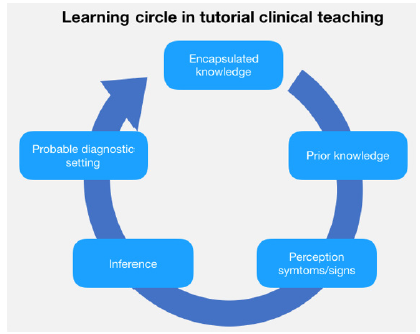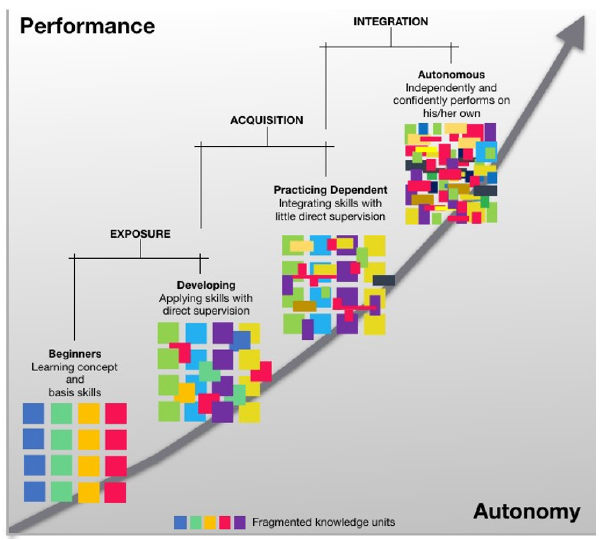Short Communication 
 Creative Commons, CC-BY
Creative Commons, CC-BY
Clinical Knowledge Construction Through Clinical Tutorial Teaching
*Corresponding author: Humberto González Oneto, Clinical Assistant Professor, School of Dentistry, Faculty of Medicine, Pontificia Universidad Católica de Chile.
Received:June 10, 2022; Published: June 20, 2022
DOI: 10.34297/AJBSR.2022.16.002255
Introduction
I have been practicing clinical tutorial teaching in a healthcare specialty program for more than 15 years and have always been deeply struck by the learning process that residents experience during their training. I often see students who easily attain skills and knowledge and others who have a rockier road ahead of them. In both cases, however, there is always one thing in common and that is having to go through the pit. By this I mean the fact of facing a cognitive conflict that will involve effort and work, sometimes frustration, until they overcome it and achieve deep learning. I have found that the transit through the pit and its subsequent successful exit depends on the ability to integrate the different subjects. Facing this phenomenon during clinical tutorial teaching has challenged me to such a level that it has pushed me to understand it. Thus, after reading a lot of literature on the subject I have learned that new knowledge in students is gradually realized in the context of the task for which it is required, consolidating when applied to concrete clinical cases. As students see more and more similar cases, they will develop shortcuts in the way their knowledge emerges from the interaction of an associative mesh that has elevated levels of understanding. This phenomenon defined as encapsulated knowledge [1] is present in the dynamics of clinical tutorial teaching and is especially useful in understanding how students learn through practice.
Rationale
The development of teaching focused on learning objectives, the constructivist approach, the promotion of autonomous learning and the integration of knowledge from problems are tools that facilitate educational work. I will delve into the constructivist approach to teaching that refers to the organization of knowledge. It is generally accepted that the ability and high performance in problem solving are direct consequences of the acquisition of knowledge in an area. When experts are asked to recall relevant information, they tend to outperform novices. However, when healthcare specialists and residents-in-training are asked to participate in the presentation of a clinical case and then invited to describe it, it is the residents who can recall more information from the case but without integrating it, unlike specialists who describe the case as a whole or a clinical entity. This phenomenon is described in the literature as an intermediate effect on clinical case recall [2-5].
To understand this phenomenon, a construction-integration model is proposed, which indicates that knowledge is not prestored in fixed structures but is generated in the context of the task for which it is required. Knowledge, according to this model, is conceived as an associative network of interacting nodes [6]. When residents attempt to understand the text of the medical record, they activate corresponding nodes that link to other related nodes. Thus, a body of knowledge is activated that may or may not be relevant to the task at hand. In this process, the resident can generate inference bridges and form macro-propositions to create or maintain coherence in text comprehension. Thus, it seems quite reasonable to assume that the more prior knowledge an individual has, the less time it will take to create a coherent base text, and consequently experts are expected to produce fewer inference bridges simply because their knowledge is automatically generated. In this sense, the individual reading a medical record transform what he or she has read into two distinct types of representations; the semantic of the text read and the constructive of the event described in the text or situational model.
Specialists have better situational models than residents, which allows them to filter out irrelevant information from the case, as they can encapsulate the knowledge due to the elevated levels of comprehension they have reached, unlike novices who understand the text in the semantic form. However, it should be kept in mind that a novice’s ability to recall details has the important function of augmenting their prior knowledge, so during tutorial clinical teaching, residents should be exposed to more and more cases, so that they will gradually establish shortcuts in the way their knowledge emerges [7]. Students construct knowledge as it is fragmented into more inclusive units under the influence of tutorial clinical teaching. (Figure 1) Taking this concept to the field of clinical training, although biomedical knowledge is important in training, it does not form the clinician, who is ultimately built through exposure to different clinical cases during daily clinical practice. In this sense, clinical tutorial teaching is of fundamental importance in the construction of knowledge, as it allows the resident to be exposed to different clinical manifestations of a disease and, with appropriate tutorial guidance, to accompany him/her in the construction and encapsulation of knowledge until clinical reasoning is reached [8].
Conclusion
After understanding how tutorial clinical teaching builds knowledge, I can communicate that for the resident to acquire elevated levels of clinical knowledge, their biomedical knowledge must be fragmented and included in units of greater projection, it being necessary for the resident to be exposed to multiple different patients and clinical situations. It is the teacher trained in clinical tutorial teaching who has the role of bringing together this biomedical knowledge and linking it with clinical experience so that it is encapsulated within higher levels of clinical knowledge [9] (Figure 2).





 We use cookies to ensure you get the best experience on our website.
We use cookies to ensure you get the best experience on our website.